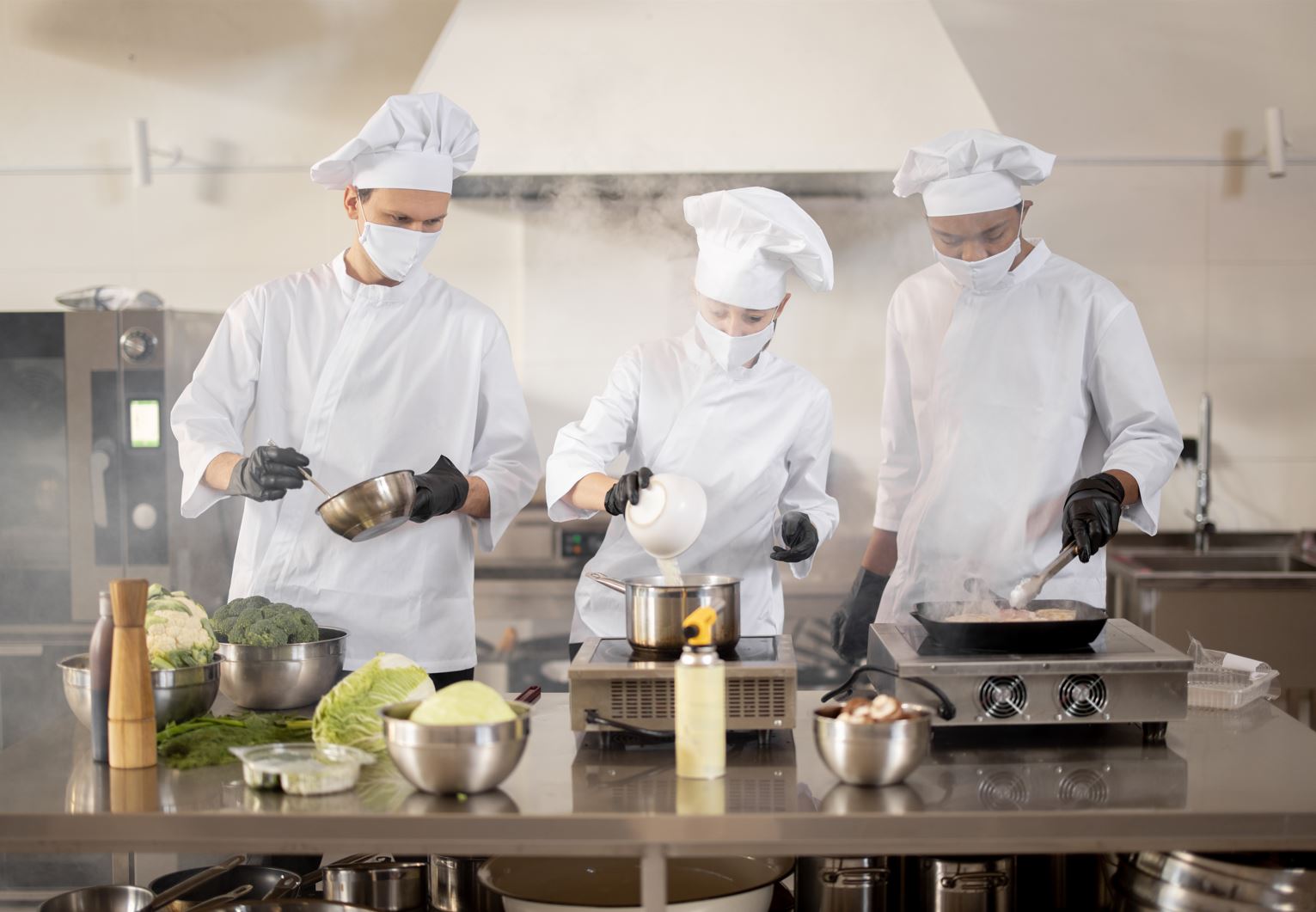
Cooking is not only an art but also a science. Behind every delicious meal, there is a fascinating chemistry that governs the transformations of ingredients during the cooking process. Understanding the chemistry of cooking can help you become a better cook and allow you to experiment with new techniques and flavors.
1. Maillard Reaction: The Maillard reaction is a crucial chemical reaction that occurs when proteins and sugars are heated together. It is responsible for the browning and development of flavors in many cooked foods, such as roasted meat, bread crusts, and cookies. Amino acids from proteins react with reducing sugars to produce a range of aromatic compounds that give food its rich, savory taste and appealing aroma.
2. Caramelization: Caramelization is the process of heating sugar until it breaks down and forms a variety of new compounds, resulting in the characteristic brown color and sweet flavor. This reaction is responsible for the delicious taste of caramelized onions, roasted vegetables, and the crust of crème brûlée.
3. Denaturation: Proteins are composed of long chains of amino acids that are folded into specific shapes. When proteins are exposed to heat, acid, or mechanical action (like whisking), the structure of the protein unfolds or denatures. This denaturation is essential in cooking, as it allows proteins to coagulate and form new textures, such as the setting of eggs or the firming of meat during cooking.
4. Emulsification: Emulsification is the process of combining two immiscible substances, like oil and water, into a stable mixture. This is essential in creating creamy sauces and dressings. An emulsifier, such as lecithin in egg yolks, helps stabilize the mixture by forming a barrier between the oil and water droplets.
5. Leavening: Leavening agents, such as baking powder and yeast, produce gases (carbon dioxide) during the cooking process, causing dough to rise and baked goods to become light and fluffy. The gas expands within the dough’s structure, creating air pockets, which give rise to a soft and airy texture.

6. Oxidation: Oxidation occurs when certain foods are exposed to air, causing chemical changes that affect flavor and color. For example, the browning of sliced apples or avocados is due to enzymatic oxidation, which can be slowed down by adding acid or refrigeration.
7. Maillard and Flavour Development in Coffee Roasting: In coffee roasting, the Maillard reaction and other chemical processes play a crucial role in developing the complex flavors and aromas we associate with coffee. The breakdown of carbohydrates and amino acids in the beans leads to the formation of various aromatic compounds, which contribute to the unique taste of each coffee variety.
8. Sous Vide Cooking: Sous vide is a cooking method that involves sealing food in airtight bags and cooking it in a water bath at a precise and consistent temperature. This technique allows for controlled cooking, minimizing moisture loss and ensuring uniform doneness. It’s particularly popular for cooking meats to precise levels of doneness.
9. Fermentation: Fermentation is a chemical process that converts sugars into alcohol or organic acids using microorganisms like yeast or bacteria. This process is essential in the production of beer, wine, yogurt, cheese, and many other foods. It not only preserves the food but also adds distinctive flavors and textures.
Understanding the chemistry behind cooking can elevate your culinary skills, enabling you to make informed choices about ingredients, temperatures, and techniques. It’s a fascinating journey that can lead to creating even more delicious and inventive meals in your kitchen.
Getting the best flavor in your dishes involves a combination of factors, including ingredient selection, cooking techniques, seasoning, and presentation.
1. Start with fresh, high-quality ingredients: Quality ingredients are the foundation of a great dish. Look for fresh produce, meats, and seafood. Local and seasonal ingredients often have superior flavor.
2. Use herbs and spices: Herbs and spices are key to enhancing the taste of your dishes. Experiment with different combinations to find what works best for the specific cuisine you’re cooking.
3. Master the art of seasoning: Proper seasoning can make a significant difference in the taste of your food. Taste as you cook and adjust the seasoning accordingly. Be mindful of using salt and don’t overdo it.
4. Build layers of flavor: Layering flavors can make a dish more complex and interesting. Use techniques like sautéing, roasting, or caramelizing to develop rich flavors.
5. Don’t forget acid and sweetness: Balancing acidity and sweetness can elevate your dishes. Consider using ingredients like citrus juice, vinegar, or a touch of sugar to enhance the taste.
6. Use the right cooking techniques: Different cooking methods can bring out unique flavors in ingredients. For example, grilling imparts a smoky taste, while braising makes meats tender and flavorful.
7. Allow time for marination: Marinating proteins or vegetables before cooking can infuse them with flavor. The longer the marination, the more pronounced the flavors become.
8. Balance the five basic tastes: Aim to balance the five basic tastes: sweet, sour, salty, bitter, and umami. A well-rounded dish should incorporate a mix of these flavors.
9. Consider texture: Texture plays a vital role in how we perceive flavor. Combining contrasting textures can make a dish more enjoyable.
10. Avoid overcooking: Overcooking can lead to loss of flavor and texture. Cook ingredients just until they are done, and avoid excessive heat.
11. Garnish strategically: The right garnish can add an extra layer of flavor and visual appeal to your dish. Fresh herbs, citrus zest, or a drizzle of high-quality oil can work wonders.
12. Pay attention to plating: How a dish is presented can affect how it is perceived. Thoughtful plating can make a meal more enticing and enjoyable.
13. Taste, adjust, and repeat: Keep tasting your food as you cook and adjust as needed. Don’t be afraid to experiment and refine your recipes over time.
14. Learn from others: Try different cuisines and dishes from various cultures to expand your palate and learn new flavor combinations.
Cooking is an art, and there’s no one-size-fits-all approach to achieving the best flavor. Don’t be afraid to get creative and have fun in the kitchen. Practice and experimentation will lead you to discover your own signature dishes with incredible flavors.
1. Basil: Best suited for Italian and Mediterranean dishes such as pasta sauces, pizza, Caprese salad, and pesto.
2. Rosemary: Great for roasted meats like lamb, chicken, and beef, as well as in potatoes and other root vegetables.
3. Thyme: Works well with poultry, fish, stews, soups, and roasted vegetables.
4. Oregano: Ideal for pizza, pasta dishes, tomato-based sauces, and Greek cuisine.
5. Parsley: Can be used as a garnish for almost any dish, especially in salads, soups, and Mediterranean recipes.
6. Cilantro (Coriander): Often used in Mexican, Indian, and Thai dishes, such as salsas, curries, and rice dishes.
7. Mint: Perfect for desserts, salads, and beverages like mojitos or mint tea. Also used in Middle Eastern cuisine.

8. Dill: Complements fish, seafood, pickles, and salads, especially in Scandinavian and Eastern European cuisines.
9. Sage: Pairs well with pork, poultry, and creamy pasta dishes.
10. Chives: Adds a mild onion flavor to dishes and works well in salads, soups, and potato dishes.
11. Tarragon: Best used with chicken, fish, and egg dishes, and commonly found in French cuisine.
12. Bay leaves: Often used in stews, soups, and braised dishes to impart subtle flavor.
Related Posts
The Science of Fat Burning: Understanding the BasicsFat burning is a complex physiological process that involves the breakdown and utilization of stored fat as an energy source by the body. Understanding the basics of fat burning can help individuals make informed decisions about their diet, exercise, and lifestyle to optimize their fat loss goals. Here are the key aspects to consider: 1. Energy Balance: At its core, fat burning is all about energy balance. When you consume more calories from food than your body needs for daily activities and functions, the excess energy is stored as fat. On the other hand, when you consume fewer calories than your body requires, it starts tapping into its fat stores to make up for the energy deficit, leading to fat burning. 2. Metabolism and Basal Metabolic Rate (BMR): Your metabolism is the total energy expenditure by your body, including processes like breathing, circulation, and cell production. Basal Metabolic Rate (BMR)…
Cooking 101: Essential Tips and Techniques for BeginnersCooking is a wonderful skill that brings joy and satisfaction to your daily life. As a beginner, it's essential to start with the basics and gradually build your culinary expertise. Here are some essential tips and techniques to get you started in the kitchen: 1. Start with Simple Recipes: Begin with easy-to-follow recipes that have fewer ingredients and straightforward instructions. As you gain confidence, you can move on to more complex dishes. 2. Preparation is Key: Mise en place, a French term meaning "everything in its place," is crucial. Before you start cooking, gather and prep all your ingredients. Chop vegetables, measure spices, and have everything within arm's reach. 3. Use the Right Tools: Invest in basic kitchen tools like a chef's knife, cutting board, pots, pans, and measuring cups. Quality tools will make your cooking experience more enjoyable and efficient. 4. Master Knife Skills: Learn basic knife techniques like…
How to grow herbs for cooking at home1. Determine which herbs you frequently use in your cooking and prioritize growing those. 2. Choose a suitable location in your home or garden that receives adequate sunlight for herb growth. 3. Decide whether you want to grow herbs indoors or outdoors, based on your available space and climate. 4. Select high-quality herb seeds or young plants from a reputable nursery or garden center. 5. Use well-draining soil suitable for herbs, or create a potting mix with compost, perlite, and vermiculite. 6. Ensure the pots or containers have proper drainage holes to prevent waterlogging. 7. Start the seeds indoors in trays or small containers, following the specific instructions for each herb. 8. Water the herbs regularly, but avoid overwatering as it can lead to root rot. 9. Consider using a water-soluble organic fertilizer to provide necessary nutrients to the herbs. 10. Provide adequate air circulation to prevent fungal diseases by…
Embracing a Wholesome Culinary Journey: Exploring the Benefits of Healthy CookingIn a world where convenience often takes precedence over nutrition, adopting a healthy style of cooking has become a powerful way to nourish our bodies and enhance overall well-being. Healthy cooking is not just about following fad diets or restricting ourselves; it's a holistic approach to preparing and enjoying food that promotes good health without sacrificing flavor and satisfaction. In this article, we'll delve into the art of healthy cooking, the benefits it offers, and practical tips to make it a rewarding and sustainable part of our culinary journey. Understanding Healthy Cooking: Healthy cooking is about embracing fresh, whole, and nutrient-rich ingredients while minimizing processed and unhealthy elements. It involves mindful choices in selecting ingredients, cooking methods, and portion sizes to ensure that the meals we prepare nourish our bodies and support a balanced lifestyle. By focusing on whole foods and incorporating a variety of fruits, vegetables, lean proteins, whole…
Basics of Nutrition: Understanding Macronutrients and MicronutrientsNutrition is the process of obtaining and consuming the nutrients necessary for the proper functioning, growth, and maintenance of our bodies. Nutrients are substances found in food that provide energy, support growth, repair body tissues, and regulate various bodily functions. They are classified into two main categories: macronutrients and micronutrients. Let's explore each of them: 1. Macronutrients: Macronutrients are nutrients that our bodies need in relatively large quantities to sustain life and carry out essential functions. They provide energy (measured in calories) and are essential for growth and metabolism. The three main macronutrients are: a. Carbohydrates: Carbohydrates are the body's primary source of energy. They are broken down into glucose, which is used by cells to produce energy. Sources of carbohydrates include grains (e.g., rice, wheat), fruits, vegetables, legumes, and sugars. b. Proteins: Proteins are essential for growth, repair, and maintenance of body tissues, as well as the production of…
Exploring Gastronomy: The Art and Science of FoodExploring gastronomy is a fascinating journey into the world of food, where art and science converge to create extraordinary culinary experiences. Gastronomy is not merely about cooking or eating; it delves deeper into the understanding of food, its origins, preparation techniques, and how it affects our senses and emotions. Let's explore the key aspects of this captivating subject: 1. Definition of Gastronomy: Gastronomy is the study of the relationship between food and culture, as well as the art and science of food and cooking. It involves understanding the history, ingredients, techniques, and traditions that contribute to the diverse cuisines found around the world. 2. Culinary Anthropology: Gastronomy encompasses the cultural and social aspects of food. It examines how food shapes and is shaped by human culture, traditions, and customs. The way people prepare and consume food is often influenced by their surroundings, beliefs, and historical practices. 3. Science of Taste:…
Understanding Calories: Balancing Intake for Weight LossUnderstanding calories and balancing your calorie intake is crucial for weight loss. Weight loss occurs when you consistently consume fewer calories than your body expends over time. To achieve this, you need to create a calorie deficit, where the calories burned are greater than the calories consumed. Here are some essential steps to understand and manage your calorie intake for weight loss: 1. Calories In vs. Calories Out: Weight loss is essentially a numbers game. Calories in represent the calories you consume through food and beverages, while calories out refer to the calories your body burns through various activities like basal metabolic rate (BMR), physical activity, and the thermic effect of food (TEF). 2. Basal Metabolic Rate (BMR): BMR is the number of calories your body needs to maintain basic physiological functions while at rest. It includes essential processes like breathing, circulating blood, and maintaining body temperature. Several factors influence…
Embracing the Present: The Art and Science of MindfulnessIn a fast-paced and ever-changing world, the concept of mindfulness has emerged as a powerful antidote to stress, anxiety, and the constant noise of modern living. Mindfulness, rooted in ancient wisdom and backed by scientific research, offers a profound way to reconnect with ourselves, our surroundings, and the present moment. In this article, we explore the essence of mindfulness, its benefits, and how to incorporate it into our daily lives to cultivate a sense of inner peace and well-being. Understanding Mindfulness: At its core, mindfulness is the practice of paying attention to the present moment with an open and non-judgmental mindset. It involves being fully aware of our thoughts, feelings, bodily sensations, and the environment around us, without getting entangled in them. Mindfulness encourages us to observe our experiences with curiosity and acceptance, fostering a deeper understanding of ourselves and the world. The Science Behind Mindfulness: Extensive research has shown…
Unlocking the Science of Ketosis: How It Facilitates Weight LossThe quest for effective weight loss methods has led to the exploration of various diets, and one that has gained significant attention is the ketogenic diet. Ketosis, a metabolic state induced by the ketogenic diet, has been hailed as a powerful tool for weight loss. In this article, we will delve into the science of ketosis and how it facilitates weight loss to help you understand its potential benefits and considerations. Understanding Ketosis Ketosis is a natural metabolic state in which the body primarily relies on fat for fuel instead of carbohydrates. Normally, the body breaks down carbohydrates into glucose, which is the primary source of energy. However, when carbohydrate intake is restricted, as in the ketogenic diet, the body switches its energy source to stored fat. As a result, the liver produces ketones, which are molecules derived from fat breakdown, to fuel the body and brain. The Ketogenic Diet…
Behind the Scenes: A Day in the Life of a Fashion DesignerAs an AI language model, I don't have personal experiences, but I can certainly provide you with an imaginary glimpse into the life of a fashion designer based on typical experiences and information available up to my last update in September 2021. 6:30 AM: Rise and Shine A fashion designer's day usually begins early. They wake up, prepare a healthy breakfast, and maybe take a moment for meditation or light exercise to get energized for the day ahead. 8:00 AM: Heading to the Studio Fashion designers often have their own studios or workspaces where they create their designs. Some might work in design houses or fashion companies. They commute to their studio, and during the journey, they might catch up on fashion news or brainstorm ideas. 9:00 AM: Sketching and Designing Once at the studio, the designer dives into the creative process. They start by sketching new designs, refining existing…



